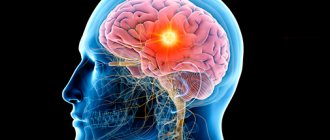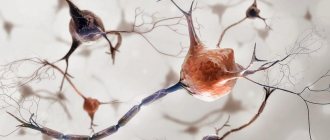what is episyndrome
Episyndrome is sudden and recurring attacks of convulsions in a child, externally similar to epilepsy.
Episyndrome is always a consequence of some disease. The attacks stop as soon as the underlying cause of which they were a symptom is cured.
If for the development of an attack of true epilepsy an epileptic focus is needed (a group of brain cells with increased electrical activity), then with episyndrome there is no such focus, therefore, when examined on an electroencephalogram (EEG), it is not found.
Frontal epilepsy (Kozhevnikov syndrome, Rasmussen encephalitis)
Kozhevnikov syndrome is a special form of perirolandic focal epilepsy, manifested in both adults and children, and associated with damage to the motor cortex. The main features of this syndrome are: (a) focal motor seizures, always clearly localized; (b) frequent appearance of myoclonus in the area of localization of somatosensory attacks in later stages of the disease; (c) on the EEG - normal background activity in combination with focal paroxysmal abnormalities (spikes and slow waves); (d) debut is possible at any age - both in children and in adults; (e) in many cases, an etiological factor is identified (tumor, vascular anomalies); (f) absence of progression, evolution of the syndrome (clinical, electroencephalographic, psychological changes), except in cases where the evolution of the disease is associated with the progression of the underlying brain lesion.
The disease usually debuts at the age of 6-10 years. The child's development is normal before the onset of the disease. Rasmussen's encephalitis is characterized by the rapid development of treatment-resistant focal seizures (usually motor or sensorimotor) in combination with slowly progressive motor deficits, which is associated with damage to one hemisphere of the brain. Later, mild or moderate dementia develops. The EEG reveals pronounced persistent arrhythmic delta waves, a disturbance in the background rhythm and a large number of spikes. Later in the development of the disease, epileptiform activity during an attack may involve different isolated areas of the same hemisphere. Pathomorphological examination may reveal gliosis, inflammation or spongy changes. The disease is usually progressive and can be fatal; in other cases, process stabilization or temporary improvement is observed over time. In a number of cases, a good therapeutic effect was noted from intravenous administration of high doses of human immunoglobulin.
P. Autosomal dominant frontal lobe epilepsy with nocturnal paroxysms
Autosomal dominant frontal lobe epilepsy with nocturnal paroxysms is characterized by nocturnal attacks that usually appear before the age of twenty, but attacks often continue into adulthood. The attacks usually occur during sleep, but in severe cases they can occur while awake. Clinical manifestations of this syndrome resemble other forms of frontal lobe epilepsy. A nonspecific aura is usually observed, which may include somatosensory, specific sensory, mental, or autonomic symptoms. After the aura, shortness of breath (intermittent breathing), groans, other variants of vocalization, pronounced motor manifestations (strikes such as boxing, tonic tension, hyperkinetic movements, clonic twitching) or reflex excitation with rapid changes in body position may appear. High effectiveness of carbamazepine was noted.
The genetic defect is mapped to chromosomes 20ql3 (CHNRA4) and lq2l (CHNRB2); Mutations in the genes encoding the α4 and β32 subunits of neuronal nicotinic acetylcholine receptors were discovered. Analysis of the functional properties of nicotinic acetylcholine receptor genes altered as a result of mutations, associated with autosomal dominant frontal lobe epilepsy with nocturnal paroxysms, showed that the cause of neuronal dysfunction that causes attacks may be increased sensitivity to acetylcholine.
causes and symptoms of episyndrome
The main cause of episyndrome is oxygen starvation of brain cells, as well as changes in their chemical state.
Such processes develop as a result of birth injuries of the cervical spine, causing a decrease in cerebral blood flow and an increase in intracranial pressure, as well as after various brain injuries (trauma, previous diseases, chemical poisoning).
The development of seizures occurs from irritation of the cerebral cortex or its deep structures and is accompanied by a flash of increased electrical activity of nerve cells (a kind of “short circuit” in the brain).
Quite often, the first attack of seizures in a child develops at elevated temperatures or after vaccination, since in such conditions intracranial pressure increases and oxygen starvation of brain cells increases.
More rare causes of episyndrome are tumors, cysts, parasites, infectious processes of the brain, toxic poisoning, underdevelopment of the brain in cerebral palsy, metabolic disorders.
Externally, an attack of episyndrome is manifested by a sudden increase in tone in the limbs, muscle spasms and twitching both in sleep and while awake, trembling of the limbs, tics, nods, rocking movements of the torso, freezing, rolling of the eyes, twisting of the torso, and cessation of breathing. These attacks are usually not accompanied by loss of consciousness.
Service price
- HOSPITAL Day hospital5 000
- Day hospital with intensive care8,000
- 24-hour hospital (all inclusive, cost per day) 12,000
- 24-hour hospital (all inclusive, cost per day). Single occupancy24,000
- 24-hour hospital (all inclusive, cost per day). Single occupancy in a superior room 36,000
- Primary family counseling for relatives of patients undergoing inpatient treatment free of charge
- Group psychotherapy for relatives of patients undergoing inpatient treatment free of charge
- Group psychotherapy for 24-hour and day hospital patients free of charge
- Individual post for a hospital patient (if indicated)6,000
Epilepsy can manifest as perceptual disturbances. At the Rosa Clinic, diagnosis, treatment and rehabilitation of epilepsy are carried out in a hospital setting and at home (outpatient).
Strange as it may sound, epilepsy can also debut in the form of olfactory disorders. Such forms of epilepsy are extremely rare, and, as a rule, are associated with the involvement of the olfactory gyrus, hippocampus, gyrus, as well as the frontal and temporal regions in the pathological process. Most often, olfactory disturbances are only a precursor or so-called “aura”, followed by typical epileptic seizures. However, although very rare, symptoms associated with a violation of the sense of smell can be a manifestation of an independent disease that can develop and lead to generalized seizures.
debunking myths about episyndrome
Today, there are a number of misconceptions about the problem of episyndrome, generated mainly by the lack of objective information among parents who are faced with this problem about the causes of episyndrome and the proposed treatment. We will try to clarify this issue and debunk the most popular myths.
Cramps at high temperatures are not a deviation
With normal functioning of the brain, even at high temperatures, seizures do not develop. Convulsions against a background of high temperature indicate a malfunction of the central nervous system.
Seizures indicate the presence of epilepsy
Epilepsy always manifests itself in different types of seizures, but not all seizures indicate the presence of epilepsy. In particular, with episyndrome, seizures develop against the background of oxygen starvation of brain cells.
Seizure attacks are treated with anticonvulsants
Anticonvulsants are used in the presence of an epileptic focus in the brain. In episyndrome, this focus is absent and the drugs do not have the expected effect - the frequency of seizures does not decrease, and sometimes even increases.
Seizures are hereditary
Most seizures are not associated with heredity, but indicate a violation of brain activity. It is extremely rare that attacks can be traced across several generations of relatives.
Seizure attacks are incurable and require lifelong medication
Only a rare hereditary form of epilepsy, in which seizures occur throughout life and the patient is prescribed symptomatic treatment with anticonvulsants, cannot be treated. Other forms of epilepsy and episyndrome are effectively treated. In each case, it is necessary to select individual treatment depending on the cause of seizures.
As can be seen from the examples described above, an objective look at the problem of episyndrome from the point of view of the causes of its occurrence and methods of solution helps the parents of a child who has been diagnosed with this disease to promptly and thoughtfully approach the choice of an effective and safe treatment method.
general information
Alcoholic epilepsy is a pathological condition that develops in response to prolonged intoxication with ethanol and its breakdown products. The pathological condition is not always characterized by the occurrence of convulsive attacks.
Alcoholic epilepsy is a secondary neurological disorder (symptomatic). Chronic alcoholism leads to damage to neurons in the brain. Disruption of electrical conductivity between neurons causes convulsive paroxysms. The pathological condition often develops in patients with alcoholism. But there have been isolated cases where a single use of a large dose of ethanol led to a seizure.
The term alcoholic epilepsy was coined in 1883. The condition was characterized by the occurrence of convulsive seizures in alcoholics. The root cause has always been organic damage to brain cells due to the toxic effects of ethanol. Almost all patients have a history of traumatic brain injuries of varying severity.
Convulsive syndrome in alcoholism / V.V. Donskoy, N.S. Sukhanova, A.M. Gusev, M.V. Kolontai – Omsk Psychiatric Journal. — No. 2 (2). – 2014.
Almost 30% of chronic alcoholics suffer from alcoholic epilepsy. Frequency of seizures depending on the stage of alcoholism:
| Alcoholism stage | Probability of occurrence |
| I | 17 – 20 % |
| II–III | 60 – 64 % |
| III | 17 – 19 % |
In all cases, the attacks occurred against the background of prolonged and daily drinking of alcohol. But at the same time, there were no epileptic signs on the EEG.
In the international classification of diseases, alcoholic epilepsy is not assigned a code. This condition is considered within other categories or subcategories of diseases.
The term alcoholic epilepsy characterizes several pathological conditions:
- An epileptic seizure is a single or episodic reaction of the central nervous system, against the background of alcoholic excess in persons who do not suffer from alcoholism. The reaction occurs as a result of a post-intoxication state (hangover);
- Episyndrome – systematic attacks. Occurs as a result of chronic alcoholism;
- True alcoholic epilepsy is episodic or systematic seizures with convulsive or non-convulsive status.
Seizures with systematic alcohol abuse are considered harbingers of alcohol psychosis.
Get help now
Do any of your relatives or friends have an addiction? Have you tried in every possible way to help, but as a result the person still returned to his past life?
You are not the first to encounter this problem, and we can help you.
We guarantee anonymity, we will persuade you to undergo treatment, and we will help you choose a center.
Call us
+7
or
Call me
about our treatment of episyndrome
If a child’s electroencephalogram (EEG) examination does not reveal an epileptic focus, then we do not see the need to prescribe anticonvulsants. When using such drugs, there is no improvement, since the cause of the development of seizures is different.
For the treatment of episyndrome, we offer an effective and safe method of traction therapy aimed at restoring cerebral blood flow and reducing intracranial pressure, as a result of which the main cause of episyndrome is eliminated - oxygen starvation of brain cells
Treatment is carried out on an outpatient basis (outside the hospital) and involves the child wearing a traction collar of an original design (
) in combination with taking natural medications to normalize brain activity.
Our treatment quickly and effectively solves the problem of episyndrome, while it is safe and reliable.
The first effects are felt within a few days from the start of treatment: the child’s well-being improves significantly, the frequency of attacks decreases and soon they stop completely
Maximum effectiveness is achieved thanks to a fundamentally different approach to solving the problem of episyndrome - our treatment is aimed at eliminating the cause, rather than suppressing the symptoms of the disease
The treatment we offer is completely safe, since the traction collar does not have a negative effect on the child’s body, and the prescribed drugs do not cause complications or side effects
After the course of treatment, seizures no longer occur, since during treatment the main cause of the disease is eliminated and the natural functions of the brain are restored
Thus, the traction therapy we offer, due to its obvious advantages, is an excellent and often the only alternative not only to taking anticonvulsants, but also to other methods of treating episyndrome.
Consequences
Alcoholic epilepsy is not characterized by personality changes of the epileptic type. But chronic alcoholism, as a rule, leads to degradation. Therefore, attacks aggravate existing changes in personality traits and cognitive sphere (deviant behavior, irritability, anger, decreased intellectual abilities).
When epileptic seizures with convulsive syndrome occur, in 100% of cases, patients are diagnosed with alcoholic encephalopathy, which is characterized by irreversible degenerative changes in the brain.
Complications:
- Traumatic brain injury during a seizure;
- Development of psychotic disorders;
- Retraction of the tongue during an epileptic attack or aspiration of vomit;
- Stopping breathing;
- Cognitive changes;
- Disability.
The frequency of seizures in alcoholic epilepsy does not exceed 2–3 episodes per year. But its danger lies in its transition to a chronic form. Attacks no longer occur against the background of intoxication, but even during a long period of sobriety. This is due to the formation of a pathological focus of excitation in the brain, which causes an epileptic attack.
In chronic alcoholism, epileptic activity is detected on the EEG. That is, the mechanisms of epileptogenesis were launched in the hippocampal parts of the brain - a carrier of epileptic activity. Continuation of alcoholism will lead to the manifestation of unprovoked epileptic seizures.
Alcoholic epilepsy / V.O. Generalov, T.R. Sadykov, Yu.V. Kazakova, V.G. Amcheslavsky, E.V. Amcheslavskaya, S.A. Likhachev, E.V. Veevnik - a manual for doctors. – Moscow – Minsk. – 2014. – 6 – 13 p.
MRI
Magnetic resonance imaging (MRI) and computed tomography have become critical tools in the diagnosis of epileptic seizures, thanks to this technology it is possible to study the activity of brain disease and changes in its tissues, the development of tumors, which are the main causes of seizures. The purpose of ordering an MRI is to check and exclude a secondary form of the disease.
Doppler ultrasound is a test that uses high-frequency sound waves to measure the amount of blood flow in your arteries and veins. They supply blood to your arms and legs. Vascular flow studies can detect abnormal flow within an artery or blood vessel to rule out secondary forms of epilepsy.
A complete blood count may be ordered by your doctor to check for and rule out inflammation that may be causing an attack.
In order to exclude tumors in the fundus, the doctor may prescribe an examination by an ophthalmologist. Often, symptomatic epilepsy can be caused by ocular pathology.
Classification of epileptic syndromes
It is necessary to determine the form of the seizure in order to focus the diagnostic approach on a specific etiological factor, select appropriate drug therapy, and conduct scientific research.
The primary (congenital) form includes hereditary transmission from parent to child. Doctors consider the presence of neurological diseases that cause seizures to be a secondary form. The latent form implies benign forms of epilepsy.
Epileptologists use a classification of epilepsy according to its type. It is important to examine the patient for the presence or absence of the disease on the basis of which epilepsy develops.
Based on the identified cause of seizures and the designated form of epilepsy, a treatment method is prescribed.
Children with epilepsy have global learning problems (developmental delays) caused by extensive brain abnormalities; more often these children have various specific learning problems, irritability, inattention, speech and writing disorders.
Epilepsy is a severe chronic disease that requires long-term therapy with careful selection of medications.
The Center for Pediatric Speech Neurology offers patients a complete examination of the nervous system, after which they will prescribe, if necessary, drug therapy and monitor the progress of treatment.
Our specialists also provide patients who have been discharged from the hospital with outpatient monitoring and assistance so that side effects of medications can be monitored and the treatment plan can be adjusted.









